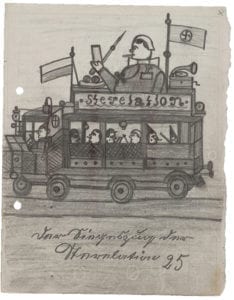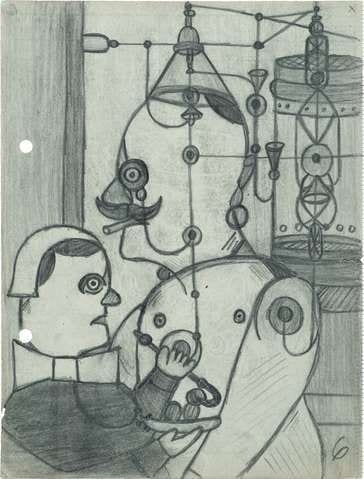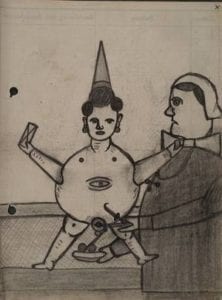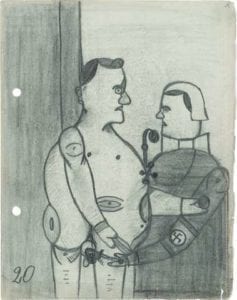Erika Silvestri
Berlin, Germany
 |
| Der Siegeszug der Sterelation, Wilhelm Werner, © Sammlung Prinzhorn, Heidelberg, Inv. Nr. 8083 (2008) fol. 25. Source |
The medical-scientific sector was among the first to adhere to National Socialism: in 1933, nine doctors sat in Parliament in the ranks of the party.1 After a century of scientific dynamism and in opposition to religious dogma, the eugenic ideal had spread throughout Europe and the United States, taking on the appearance of a biological theology.
In Germany, it translated into what Alfred Ploetz called Rassenhygiene, the union of social science and hereditary biology that conceived of society as a single body, whose preservation had priority over the life of the individual.
After Adolf Hitler’s seizure of power, the nature of the medical profession’s philosophy changed radically: from the care and safeguarding of the individual’s health, the center of attention was moved to the physical state of the Volkskörper, i.e. the total body of the Volk.
While the traditional physician devoted himself particularly to the care of the weak, the new physicians of the National Socialist era had to give priority to the strong and to the young in order to build the necessary physical basis for the future of the nation.
Wilhelm Werner was born into a family of humble origins on 18 September 1898 in Schnieglin, near Nuremberg. In 1902, his mother moved to the poorhouse, together with Wilhelm and a baby, born two years after Wilhelm. Probably deaf, at the age of ten Wilhelm was admitted to St. Joseph’s Home, a Catholic institute for the feeble-minded located in Gemünden, Franconia, where he learned to read and write. In 1919 he was transferred to the Werneck mental hospital, where he was diagnosed as having Idiotie and where he remained until 1940. We do not know the exact date on which he was forcibly sterilized, but it happened between 1934 and 1938.2
National Socialist Germany was not the first country to introduce sterilization by legal means: in twenty-eight US states, laws were already in place by the end of the 1920s favoring the sterilization of categories of individuals considered genetically dangerous.
 |
| Der Siegeszug der Sterelation, Wilhelm Werner, © Sammlung Prinzhorn, Heidelberg, Inv. Nr. 8083 (2008) fol. 6. Source |
On July 14, 1933, just six months after Hitler became Chancellor, interior minister Wilhelm Frick enacted the Gesetz zur Verhütung erbkranken Nachwuchses, which came into force in January 1934 and involved the forced sterilization of individuals whose offspring had hereditary physical or mental “damage,” and of all the people suffering from certain pathologies considered hereditary.3 The text of the law was inspired by the Model Eugenical Sterilization Law that Harry Laughlin presented in his essay Eugenical Sterilization in the United States, published in 1922. Each case had to be examined by an Erbgesundheitsgericht, a Hereditary Health Tribunal. According to Aly Götz, 350,000 people, including Wilhelm Werner, were sterilized in the first seven years of the Third Reich.4
On October 15, 1935, the Gesetz zum Schutze der Erbgesundheit des deutschen Volkes was enacted to prevent marriage if one of the spouses had an inherited, contagious disease or was under legal protection. With the invasion of Poland, Hitler did not declare war only outside the German nation, but also internally, decreeing the beginning of the Aktion T4 program.
The order that started the operations was written down only in the autumn of 1939, but Hitler had ordered it back on September 1, the same day that the German armies entered Polish territory. It was the Ministry of the Interior that issued the strictly confidential decree Meldepflicht für mißgestaltete usw. Neugeborene, on August 18, 1938, which ordered doctors and midwives to register all children under the age of three and for whom a hereditary disease was suspected, through a declaration.5
The completed questionnaires would then be sent to the Reich Committee for the scientific detection of serious hereditary and congenital diseases, directed by Hitler’s private Chancellery and in collaboration with the Ministry of the Interior, which examined them.
 |
| Der Siegeszug der Sterelation, Wilhelm Werner, © Sammlung Prinzhorn, Heidelberg, Inv. Nr. 8083 (2010) fol. 6. Source |
The executive offices of the Committee were in Tiergartenstrasse 4, so the program was given the code name of Aktion T4.
If the outcome was positive, the patient was transferred to one of the clinics prepared to kill patients eligible for treatment. After a first phase that concerned the killing of children, the program went on to kill adults, and not only the sick, but also prisoners of the concentration camps, including Jews and Gypsies.
Although the program was officially interrupted on August 24, 1941, following protests by the Catholic clergy, the actions continued until the end of the war. It is estimated that overall, from 1939 to 1945, around 200,000 people were killed.6 The medical personnel who participated in the realization of the Aktion T4 was not just composed of Nazis, and in most cases they continued to carry out their work after the war.
On 6 October 1940, Werner was transferred to the euthanasia center of Pirna-Sonnenstein, where he was killed at the age of forty-two.7 This is all we know about him.
During the years he spent in Werneck, Werner made some drawings on the back of the pages of an already-filled notebook, he signed the first page and numbered thirty tables.
In 2008, Sammlung Prinzhorn bought the first part of the notebook from a private individual, and the collection was then expanded in 2010 with fourteen additional drawings.8 That same year, the Sammlung held an exhibition of Werner’s works, which were also displayed four years later in another show organized by the Deutsche Gesellschaft für Psychiatrie und Psychotherapie, Psychosomatik und Nervenheilkunde (DGPPN).
We have no definite information about Werner’s life in the institution and the diagnosis itself does not allow us to understand whether he was suffering from a hereditary disease or what his specific disorder was. The extraordinary expressiveness of his drawings shows how clearly he could read the reality surrounding him, and how critically he could describe his feelings and thoughts about what he was experiencing.
He decided – and this is no small matter – to write about what had been done to him against his will. Perhaps he wanted to share information about his condition by creating a “visual dialogue” with the people who lived with him and were in his same situation, or maybe he wanted to leave traces of his story, or hoped that someone would remember him in the future. We will never know for sure.
 |
| Der Siegeszug der Sterelation, Wilhelm Werner, © Sammlung Prinzhorn, Heidelberg, Inv. Nr. 8083 (2008) fol. 20. Source |
In one of the drawings, he portrays himself as a very small puppet in the presence of a strange machine operated by a nun: better than any narrative description, with his pencil stroke Werner manages to tell how his condition as a psychiatric patient made him feel small and lonely, at the mercy of complex actions that he could not understand and manage.
Other tables recount the forced sterilization he had to go through, depicted through the recurring drawing of his sexual organ cut and placed on a plate held by the nun.
He is naked, his expression is empty and fixed, and at the center of his chest is his navel or perhaps an eye to suggest how seeing and perceiving are not so far apart, as if behind his empty human shell, condemned by power (the nun has a swastika on the arm) to a lonely death, far from his family, was a person capable of feeling.
In another drawing, Werner depicts himself standing, holding a plate filled with his genitals in his hand. He is in a precarious balance, on one leg, he seems to oscillate and lose stability: he is no longer who he was before, he seems to have lost his identity. He has become a wire-operated puppet that has lost all human characteristics; he looks so different from Dr. Weinzierl, the only character whom he mentions by name, perfectly dressed and with the medical tools in his hands.
In a delicate and heart-breaking way, Werner shows us the point of view of the lebensunwertes Leben, the “lives not worth living” that Karl Binding and Alfred Hoche defined as absolut zwecklos, absolutely aimless, leeren Menschenhülsen, empty human shells, Ballastexistenzen, ballast existences.9 According to the two authors, such existences could not be considered as a legal asset, because they had no value for society and it is precisely by removing from them all human dignity that Binding defines them in the text published in 1920. For Hoche, the German psychiatrist who signed the medical dissertation of the work, there can be no compassion where there is no suffering, and therefore the killing of a life that has no value is not a murder.
That inverted image of the authentic people, which is what Werner was for the National Socialist power, expressed his need to live through some small pages, now yellowed by time, thus showing us his great awareness, which today takes on the form of an act of rebellion.10
End Notes:
- Proctor R. N., Racial Hygiene, London, Harward University Press, 1954, p. 65.
- Schneider F. and Lutz P., Erfasst, verfolgt, vernichtet., Berlino, Springer, 2014, p. 55.
- On the same day, it was approved the Concordat with the Catholic Church. To avoid complications with the Vatican, the law was not published until July 25th and became official from January, 1934.
- Götz A., Zavorre, Torino, Einaudi, 2017, p. 4.
- It was not published on the Official Gazette.
- Götz A., Zavorre, Ibid.
- Schneider F. and Lutz P., Erfasst, verfolgt, vernichtet., Ibid.
- Röske T. and Rotzoll M., Documents of a victims, Rawvision, https://rawvision.com/articles/documents-victim
- Binding K. and Hoche A., Die Freigabe der Vernichtung lebensunwerten Lebens., Meiner, Leipzig, 1920.
- De Cristofaro E. and Saletti C., Precursori dello sterminio, Verona, Ombre Corte, 2012, p. 66.
ERIKA SILVESTRI was born in Rome, where she specialized in the history of Nazi Germany and the crimes of National Socialism. She collaborates with Italian and German institutes and currently works on a research project on the Nazi Euthanasia Program Aktion T4, at the Friedrich Meinecke Institute of FU Berlin.
Spring 2019 | Sections | History Essays

Leave a Reply